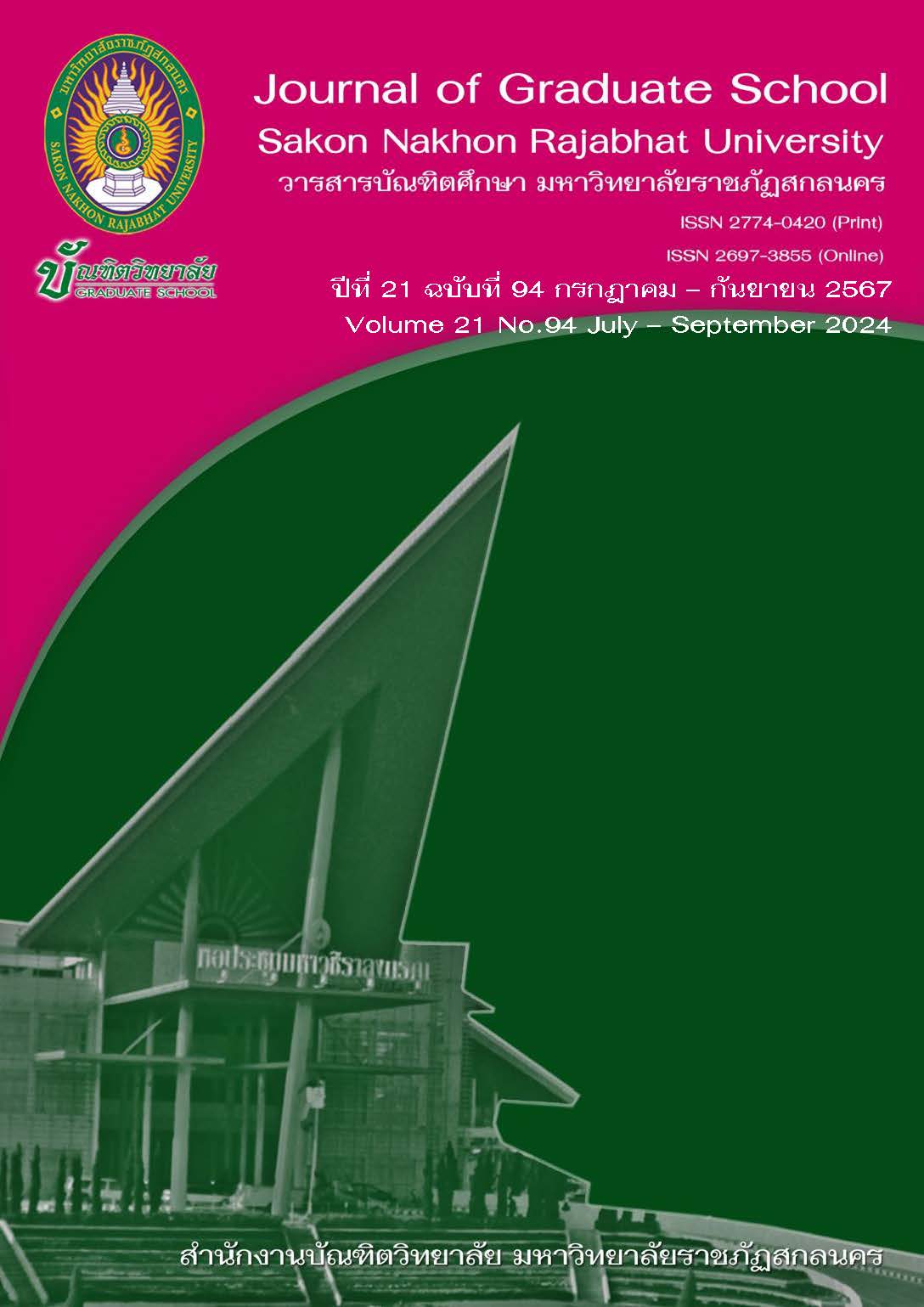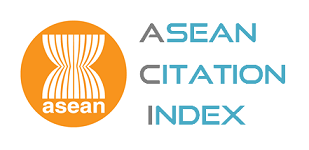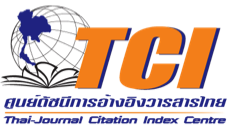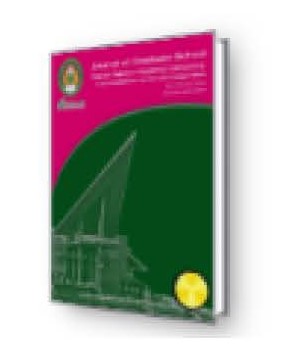COLLABORATIVE GOVERNANCE FOR DEVELOPING THE DOWNSTREAM IRRIGATION AREA OF THE RAJJAPRABHA DAM
Keywords:
Collaborative Governance, Irrigation Development, Downstream Catchment Area of Rajjaprabha DamAbstract
The objectives of this research were 1) to examine and analyze the potential of the downstream catchment area of Rajjaprabha Dam (Cheow Lan) in Surat Thani province, 2) to compare collaborative governance for developing the irrigation systems at the area downstream of Rajjaprabha Dam (Cheow Lan) in Surat Thani province, classified by demographic factors, and 3) to propose the Collaborative Governance Model for Irrigation Development Model in the aforementioned catchment area. The methodology of research was mixed methods research. Data gathering was divided into two steps: 1) collecting quantitative data by using a set of questionnaires on sample group of 390 residents from a randomly chosen sub–district in each of the three districts, using Yamane formula and then distributed proportionately to each of the sub–district; and 2) collecting qualitative data by interviewing sample groups of ten key stakeholders, including community leaders, government officials in locality, politicians in locality and business sectors, and relevant public educators or administrators.
The findings revealed that: 1) The potential of the areas receiving benefits from the dam, which comprises 113,000 rai of the downstream catchment area, and 74,000 rai of irrigation areas, covering three districts with eight sub–districts from Ban Ta Khun district, Khiri Rat Nikhom district, and Phunphin district. Residents in the downstream catchment area primarily engage in agriculture, focusing on agronomy and horticulture. Key economic crops include rubber, oil palm, coconuts, durians, and rambutans. Water from the Rajjaprabha Dam is usually released solely for electricity production, leading to water shortages during the dry season, especially in areas lacking adequate water storage and distribution systems, 2) Demographic factors, such as age and monthly income, affected the opinions toward the collaborative governance for developing irrigation systems in the downstream catchment areas differently at a statistically significant level of .05; whereas demographic factors, such as gender, marital status, education level, occupation, and the duration spent living in the districts concerned showed no differences at a statistically significant level of .05, and 3) The Collaborative Governance for Irrigation Development Model (CoGID Model) suggests that under the four pillars of the community, the collaboration across all sectors, social capital, network management, and participatory irrigation project management are essential to achieve security, wealth, and sustainability.
References
กลุ่มงานบริหารยุทธศาสตร์กลุ่มจังหวัดภาคใต้ฝั่งอ่าวไทย. (2564). แผนพัฒนากลุ่มจังหวัดภาคใต้ฝั่งอ่าวไทย. เข้าถึงได้จาก http://www.khoontadwai.go.th/files/com_networknews/2023–01_a2bab7ceaf33cf4.pdf. 1 ธันวาคม 2566.
ชลประทาน, กรม. (2561). รายงานแผนหลักการพัฒนาลุ่มน้ำ จังหวัดสุราษฎร์ธานี. สุราษฏร์ธานี: สำนักบริหารโครงการ.
ฐกร กาญจน์จิรเดช มยุรี รัตนเสริมพงศ์ และ สมบูรณ์ สุขสำราญ. (2561). รูปแบบการมีส่วนร่วมของชุมชนในการบริหารจัดการน้ำอย่างยั่งยืนของจังหวัดอุทัยธานีตามแนวปรัชญาเศรษฐกิจพอเพียง. วารสารสันติศึกษาปริทรรศน์ มจร, 6(2), 537–552.
ธานินทร์ คงศิลา และ อนุสรณ์ กุลวงษ์. (2560). การมีส่วนร่วมของเกษตรกรในการใช้น้ำชลประทาน โครงการพัฒนาลุ่มน้ำก่ำอันเนื่องมาจากพระราชดำริ. วารสารการอาชีวะและเทคนิคศึกษา, 7(14), 59-67.
พิมพวัลย์ ปรีดาสวัสดิ์ และ วาทินี บุญชะลักษี. (2536). การวิเคราะห์เครือข่ายสังคม. นครปฐม: สถาบันวิจัยประชากรและสังคม มหาวิทยาลัยมหิดล.
วริศธิ์นันย์ เสือทอง และ ณัฐธยาน์ รังสีธนานนท์. (2564). การบริหารเครือข่าย. ในเอกสารการสอนชุดวิชา สัมมนาการบริหารการปกครองท้องที่ หน่วยที่ 8 สาขาวิชาวิทยาการจัดการ มหาวิทยาลัยสุโขทัยธรรมาธิราช. นนทบุรี: โรงพิมพ์มหาวิทยาลัยสุโขทัยธรรมาธิราช.
วรัชยา เชื้อจันทึก ไกรศักดิ์ รักพินิจ และ กาญจนา คำผา. (2564). แนวทางการบริหารเครือข่ายกลุ่มผู้ใช้น้ำชลประทาน เพื่อเพิ่มประสิทธิภาพการบริหารจัดการภาครัฐด้านการบริหารจัดการทรัพยากรน้ำ: กรณีศึกษาลุ่มน้ำลำตะคอง. วารสารการบริหารการปกครอง, 10(2), 211–232.
เสาวนีย์ วิจิตรโกสุม. (2551). การจัดการทรัพยากรน้ำในลุ่มน้ำล้ำตะคองแบบบูรณาการ. ดุษฎีนิพนธ์ วท.ด. กรุงเทพฯ: จุฬาลงกรณ์มหาวิทยาลัย.
อังกูร แก้วย่อง. (2562). รูปแบบการบริหารจัดการน้ำแบบบูรณาการ: โครงการส่งน้ำและบำรุงรักษา ลุ่มน้ำโก–ลก จังหวัดนราธิวาส. ดุษฎีนิพนธ์ ปร.ด. สงขลา: มหาวิทยาลัยทักษิณ.
Bevir, M. (2012). Governance: A very short introduction. Oxford: Oxford University Press.
Bovaird, Tony and Loeffler, Elke. (Editors). (2016). “Public Governance in a Network Society” (by Elke Löffler) in Public Management and Governance. (3rd ed). Milton Park, Abingdon, Oxfordshire, UK. Routledge.
Osborne, S. P. (2010). Introduction The (New) Public Governance: A suitable case for treatment?. In The new public governance?. UK: Routledge
Patricia Kennett. (2008). Introduction: governance, the state and public policy in a global age. In Kennett, Patricia. (ed). Governance, Globalization and Public Policy. Cheltenham, UK: Edward Elgar.
_______. (2008). Governance, Globalization and Public Policy. UK: Edward Elgar Publishing Limited.
Provan, K. G., & Kenis, P. (2008). Modes of network governance: Structure, management, and effectiveness. Journal of Public Administration Research and Theory, 18(2), 229–252.
Victor Pestoff & Taco Brandsen. (2010). Public governance and the third sector: opportunities for coproduction and innovation. In New Public Governance? Emerging perspectives on the theory and practice of public governance (pp.223 – 235). Milton Park, Abingdon, Oxfordshire, UK: Routledge.
Downloads
Published
How to Cite
Issue
Section
License
Copyright (c) 2024 Journal of Graduate School Sakon Nakhon Rajabhat University

This work is licensed under a Creative Commons Attribution-NonCommercial-NoDerivatives 4.0 International License.
บทความทุกบทความที่ตีพิมพ์ในวารสารบัณฑิตศึกษา มหาวิทยาลัยราชภัฏสกลนคร ถือว่าเป็นลิขสิทธิ์ของบัณฑิตวิทยาลัย มหาวิทยาลัยราชภัฏสกลนคร










